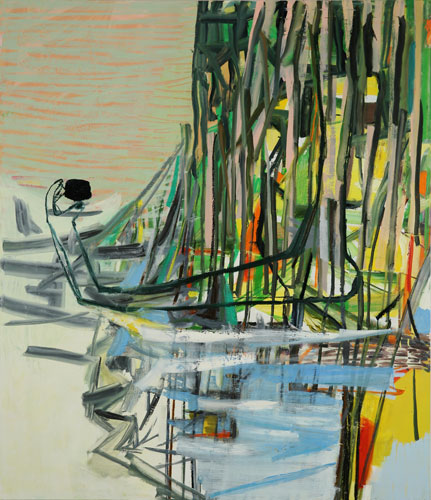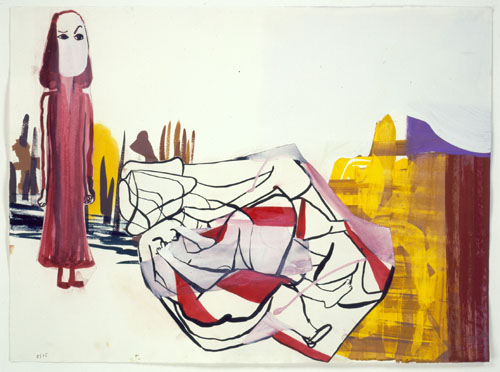Amy Sillman
Get the Moon
2006
Oil on canvas
80 x 69 inches
Untitled
2006
Oil on canvas
45 x 39 inches
Untitled
2006
Gouache on paper
22 x 30 inches
For a while now, especially since September 11, people across the cultural landscape have railed against and called for the end of irony. Many in the art world bemoan and begrudge irony. I think it's criminal to call for the death of any kind of laughter. Irony is amazingly effective at making this world, not an ideal world, matter. Artists like Barnett Newman and Mark Rothko had no irony in their brushstrokes; they were after something eternal. Irony touches on the universal but also addresses its opposites: the here, the now, and the fleeting. Without irony art can turn starchy.
Amy Sillman at Sikkema Jenkins & Co., installation view, 2006
Which brings us to the intrepid Amy Sillman. In sulky moments I sometimes think that if Sillman were a German male painter she'd be more famous. Then I remind myself that the reasons she's more of a local hero than a player on the world stage have as much to do with the zeitgeist, of which institutionalized sexism is only one part, as they have to do with Sillman's strengths and weaknesses as a painter.
Sillman is an artistic gypsy, a nervy painter who loves mid-century abstraction and modernism, someone whose work can be borderline abstract expression!istic. Sillman traverses the gap between Philip Guston's early abstraction and his later "stumblebum" figuration. She seems smitten with de Kooning, Diebenkorn, Gorky, Giacometti, Matta and even Julian Schnabel. This means that the irony in her art, to the extent that it's there at all, is recessive. This can cause Sillman's work, as bold as it is, to sometimes look old-fashioned.
Amy Sillman
Your Affection
2006
Sikkema Jenkins & Co.
Sillman isn't following in the footsteps of Gerhard Richter. She isn't mining the seam between the handmade and the mechanically reproduced or working with pre-approved painterly tropes. She is less concerned with conceptual and deconstructive practices than someone like the Cologne-based Michael Krebber, who was on the cover of Artforum last October. She doesn't explore appropriative and reproductive strategies like Kelley Walker, 37, whose snazzy work was also recently featured on Artforum's cover. Unlike Luc Tuymans, who at 50 is the same age as Sillman and has graced the covers of numerous art magazines, Sillman doesn't explore the convergence of painting and photography. Instead, Sillman's paintings are rooted in issues of gesture, space, and personal narrative. Although this keeps Sillman to one side of the action it also makes her a kind of artistic hero to younger painters who want to go their own way. Sillman is a stellar example of an artist interested in having a 30-year career and not just a 30-month career.
Amy Sillman
March
2003
“I am curious (yellow)”
Brent Sikkema Gallery, 2003
She's also an up-and-down artist. Sillman's last solo show three years ago was strong but transitional. She was obviously trying but hadn't reconciled painting and drawing on a single canvas. Her loopy drawing tended to neutralize the ropy physicality of her paint. Goofiness and gawkiness reinforced one another rather than generating their own gravity. Cartooniness resulted. Her colors were enticing, but there was an overuse of a sort of Creamsicle pastel, which undermined the emotional pull of her work. She hadn't nailed a memorable image. My review of that germinating exhibition ended with a wish, "Let's hope that Sillman gets where she's trying to go."
Here, she almost has, and it's a gutsy sight. There are still no memorable images in the eight paintings in her current show, her best yet, but the pictures of a spinach-colored hand reaching across a lavender field holding a little bird; arms or legs extending from thunderheads of brushstrokes; and fingers extending from the groin of an amorphous mass to a doorknob are all gripping. The close-up quality of these images and sculptural composition make these paintings optically aggressive in great ways. Her last show had the sexually suggestive title "I am curious (yellow)," but that exhibition was more fable-like. Sillman says, "This exhibition is about sex." I don't see that, unless it's the metaphysical sex of one plus one equals one, of separate things mingling. Basically, Sillman has gotten more in-your-face and less folksy. The sexual part of this work may be that she is approaching the abjectness of the body in riskier, more vulnerable and elemental ways.
Amy Sillman
Untitled
2006
Sikkema Jenkins & Co.
Sillman's new work wears its influences proudly while being freer, more individualistic, and confident. Colors are complex, brushstrokes aren't as overwrought, marks are more distinct, and space is blunt and weaves in and out. Rather than sex, these paintings are narratives of their own making. That hand reaching out of the bulbous mass holding onto the bird is attempting to identify, grasp, or experience the otherness of creativity. The arm holding onto what might be Malevich's Black Square is an image of the attempt to harness the alchemical power of painting. The hand holding a doorknob is, like Sillman herself, trying to open a seal between worlds.
Amy Sillman
Conjurer
2006
Sikkema Jenkins & Co.
JERRY SALTZ is art critic for the Village Voice, where this article first appeared. He can be reached at Jsaltz@VillageVoice.com
'미술사랑 > 해외작가소개방' 카테고리의 다른 글
| [스크랩] Roberto Matta (0) | 2008.06.25 |
|---|---|
| [스크랩] Frans HALS (0) | 2008.06.17 |
| [스크랩] 위엔민준 (0) | 2008.06.09 |
| [스크랩] A.R. Penck (0) | 2008.06.09 |
| [스크랩] 카라워커(Kara Walker) (0) | 2008.06.03 |


